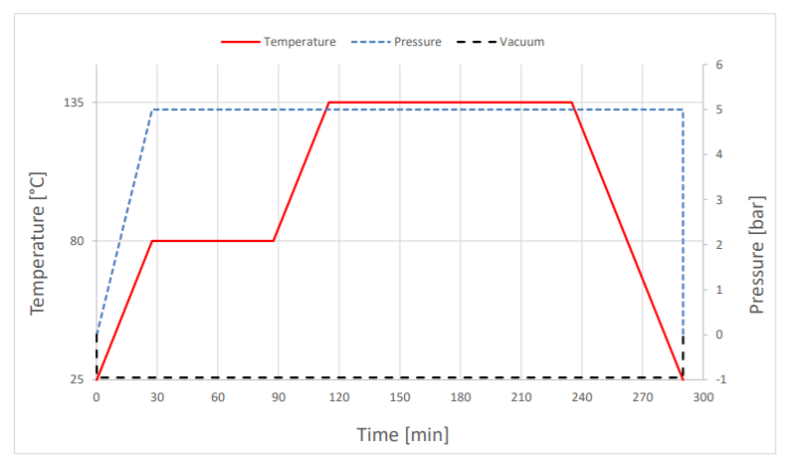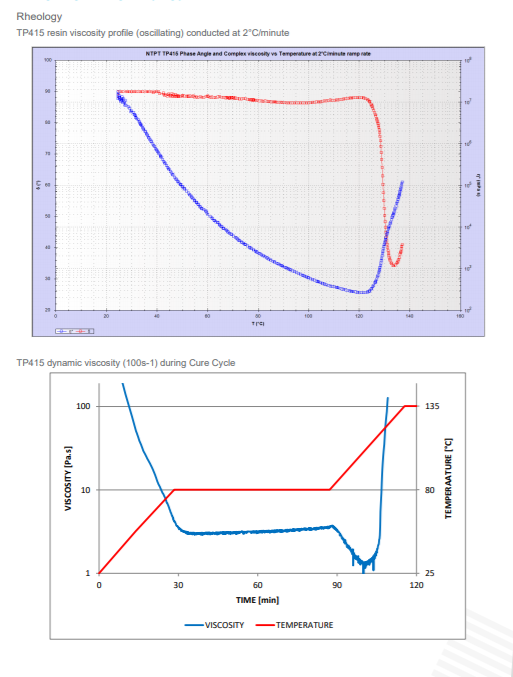Knowde Enhanced TDS
Identification & Functionality
- Chemical Family
- Polymer Name
- Reinforcement Material
- Composite Materials Functions
- Technologies
Features & Benefits
- Materials Features
- Highlights
TP415 is commonly used in autoclave processes, press molding but also curable with vacuum-only processing. TP415 achieves very good mechanical properties (like Gic >700 J/m2 on T800S fiber) with a medium Tg and quite versatile in term of curing (from 90°C to 135°C) which make it suitable for sporting good regarding tooling and processes. NTPT prepreg products are often used with automated tape laying machines (ATL). Our products are formatted both for ATL and for manual layup.
- Features
• Very high toughness (crack propagation) combining high-elongation
• Ideal for ultra-light weight sandwich (UD fiber weights from 15gsm to 150gsm)
• Can be use as adhesive core bonding (foam)
• Curable from 90°C to 135°C
• Suitable tack for hand layup and automated tape placement processes
• Available with a wide range of fiber (carbon, glass, Quartz, PBO, …)??
Applications & Uses
- Applications
- Composites End Use
- Composites Processing Methods
- Instruction for Use
Curing cycles
For the best crosslinking density and Tg of the composite, the laminate should be cured at 135°C for a minimum of 2 hours. However, lower curing cycles are possible, by reducing the temperature and extending the time (until 90°C for 8h minimum)
Standard Curing Cycle: This is the cycle use to achieve the datasheet values
 Note: NTPT recommends 2 hours at 135°C cure cycle to fully cross link the TP415 matrix resin and develop the best balance properties for the composite. Lower temperature cure cycles are possible (from 90°C) giving a lower Tg. NTPT always advises that users should perform tests and satisfy themselves on the suitability of the product and the intended cure cycle through the manufacture of and mechanical testing of tests panels before commencing the production item. Please contact NTPT Technical Services department for further advice on this point.
Note: NTPT recommends 2 hours at 135°C cure cycle to fully cross link the TP415 matrix resin and develop the best balance properties for the composite. Lower temperature cure cycles are possible (from 90°C) giving a lower Tg. NTPT always advises that users should perform tests and satisfy themselves on the suitability of the product and the intended cure cycle through the manufacture of and mechanical testing of tests panels before commencing the production item. Please contact NTPT Technical Services department for further advice on this point.Attention: In cases when TP415 is envisaged to be used in thick laminate format i.e. >6mm in thickness, extra care needs to be taken with the curing. We recommend a slow ramp rate, as well as well one or two intermediate dwells so that cross linking energy can be managed. We recommend that precautions are taken so that in the event that an uncontrolled exothermic reaction is created, there should be some user intervention and laminate temperature should be actively managed lower. Management strategies include removing the heat source used for curing e.g. turn off the press or oven, passing cooled air over the part, or in extreme situations submerging the part in a large reservoir of cold water (can be done with the part remaining in the vacuum bag). TP415 users can seek specific advice on this point by contacting NTPT’s Customer Support Team. NTPT advises that in all cases trials and sample parts should be made to confirm the suitability of process parameters to confirm the intended cure cycle will produce the parts as planned. NTPT specifically limits its liabilities to zero from damages caused through the use of NTPT products in the manufacturing processes of our customers.
Material preparation
When preparing the lay-up, the prepreg should be removed from the freezer and allowed to thaw in a sealed bag. This may take 6 to 24 hours depending on roll size. This prevents atmospheric moisture from condensing on the prepreg which may cause voiding on cure. The mold surface should be release coated and must have been tested for vacuum integrity prior to lay-up. Thin laminates: When using very thin laminates (e.g. with a total laminate fiber weight of less than 300gm2 ), care needs to be taken to avoid extracting excessive amounts of resin during the cure process. To avoid this, a microporous release film can be used, and for particularly critical components, a prepreg peel ply should be used.
Laying-up
The following procedure is recommended for preparing vacuum cured laminates.
1. Place the lay-up on a tool or caul sheet which has been treated with a release agent or film. Insert a thermocouple into the lay-up near the center ply of the thickest edge section, outside the net trim line. A separate prepreg nylon peel ply is available for covering a mold tool prior to lay-up in order to leave a clean, textured surface for subsequent bonding.
2. Apply a peel ply to the surface of the lay-up. Note that for good secondary bonding of a peel-plied surface of a TP415 prepreg laminate, a nylon peel ply is strongly recommended. This is particularly important where the cure temperatures are in excess of 90°C. Cover the peel ply entirely with a perforated release film. Normally, no edge resin bleeder system is used.
3. Install a vacuum bag by standard techniques. Insert at least two vacuum stems through the bag connecting one to the vacuum source and the other, at a point on the part furthest from the source, to a calibrated vacuum gage. Position part in the oven or autoclave and draw vacuum to check for bag or system leaks.
4. Follow the recommended cure cycle as above.
5. Upon completion of cure, turn off heat and cool until part temperature has fallen below 60°C. When fully cooled, the part may be debagged, trimmed and machined as necessary. A post-cure is not required.
Regulatory & Compliance
- Notice and Disclaimer
The Company strongly recommends that Customers make test panels and conduct appropriate testing of any goods or materials supplied by the Company to ensure that they are suitable for the Customer’s planned application. Such testing should include testing under conditions as close as possible to those to which the final component may be subjected. The Company specifically excludes any warranty of fitness for purpose of the goods other than as set out in writing by the Company. All advice, instruction or recommendation is given in good faith but the Company only warrants that advice in writing is given with reasonable skill and care. No further duty or responsibility is accepted by the Company. All advice is given subject to the Terms and Conditions of sale (the Conditions) which are available on request from the Company. The Company reserves the right to change specifications and prices without notice and Customers should satisfy themselves that information relied on by the Customer is that which is currently published by the Company on its website. Any queries may be addressed to the Technical Services Department.
Technical Details & Test Data
- Product Format
TP415 STANDARD PRODUCT FORMAT USE Hand Lay-up Preform from ATL Backing Paper Silicon paper (50 or 100µm) Silicon paper (75µm) or polyester foil (50µm) Top release None or Polyethylene foil Polyethylene foil or embossed Width [mm] 300 mm up to 1500mm Available FAW [gsm] Range from 15gsm to 150gsm per 30gsm step from 30gsm from 2 to 8 layers (16 with thin ply) Mass Resin Content [%] Range from 30% to 55% (thin ply 38% minimum) Cardboard tube [mm] Inner diameter 76mm (3 inches) 300mm Width 320mm 1600mm - Typical Characteristics

Safety & Health
- Health and safety
TP415 contains epoxy resins which can cause allergic reaction. When uncured, TP415 should be handled with appropriate gloves. When cured, a composite laminate made of TP415 should be cut, drilled or machined in a room equipped with an exhaust ventilation and filtration system, by operators wearing protective cloth and masks. Refer to Material Safety Data Sheet for further information.
Storage & Handling
- Storage
Storage Temperature Value Unit Shelf Life (-18°C) 24 Months Out Life (+18-22°C) 8 Weeks Tack Life (+18-22°C) 8 Weeks All prepreg materials should be stored in a freezer when not in use to maximize their useable life, since the low temperature reduces the reaction of resin and catalyst to virtually zero. However, even at -18°C, the temperature of most freezers, some reaction will still occur. In most cases after some years, the material will become unworkable.

